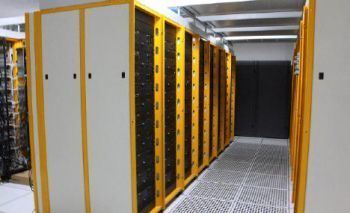 | ||
India's supercomputer program was started in late 1980s because Cray supercomputers were denied for import due to an arms embargo imposed on India, as it was a dual use technology and could be used for developing nuclear weapons.
Contents
- INDIAs Rank in Top500
- Aaditya
- Anupam
- PARAM Yuv II
- SAGA
- EKA
- VIRGO
- Vikram 100
- PARAM Yuva
- Cray XC40
- Future supercomputers
- References
PARAM 8000 is considered India's first supercomputer. It was indigenously built in 1991 by Centre for Development of Advanced Computing and was replicated and installed at ICAD Moscow in 1991 under Russian collaboration.
INDIA's Rank in Top500
As of July 2016, India has 9 systems on the Top500 list ranking 110, 139, 186, 217, 337, 397, 414, 435 and 439. .
Aaditya
Indian Institute of Tropical Meteorology, Pune, has a machine with a theoretical peak of 790.7 teraflop/s, called Aaditya, which is used for climate research and operational forecasting. It ranked 96th among the world's top 500 supercomputers June 2013 list.
Anupam
Anupam is a series of supercomputers designed and developed by Bhabha Atomic Research Centre (BARC) for their internal use. It is mainly used for molecular dynamical simulations, reactor physics, theoretical physics, computational chemistry, computational fluid dynamics, and finite element analysis. The latest in the series is Anupam-Aagra clocked at 150 TFLOPS.
PARAM Yuv II
Unveiled on 8 February 2013, this supercomputer was made by Centre for Development of Advanced Computing in a period of three months, at a cost of ₹160 million (US$2 million). It performs at a peak of 524 TFLOPS, about 10 times faster than the present facility, and will consume 35% less energy as compared to the existing facility. According to CDAC, the supercomputer can deliver sustained performance of 360.8 TFLOPS on the community standard Linpack benchmark, and would have been ranked 62 in the November 2012 ranking list of Top500. In terms of power efficiency, it would have been ranked 33rd in the November 2012 List of Top Green 500 supercomputers of the world. It is the first Indian supercomputer achieving more than 500 teraflops.
Param Yuva II will be used for research in space, bioinformatics, weather forecasting, seismic data analysis, aeronautical engineering, scientific data processing and pharmaceutical development. Educational institutes like the Indian Institutes of Technology and National Institutes of Technology can be linked to the computer through the national knowledge network. This computer is a stepping stone towards building the future petaflop-range supercomputers in India.
SAGA
SAGA built by ISRO, is capable of performing at 450,000 gigaflop/s (450 teraflop/s). It uses about 400 NVIDIA Tesla C2070 GPUs and 300 NVIDIA Tesla M2090 GPUs for acceleration and 400 Intel Intel QuadCore Xeon CPUs and 330 Intel Intel HexCore Xeon CPUs for proceesing. Storage Capacity is 120 TeraBytes.
EKA
EKA is a supercomputer built by the Computational Research Laboratories with hardware provided by Hewlett-Packard.This is developed by Tata sons. It is capable of performing at 132800 gigaflop/s or 132 teraflop/s.
VIRGO
Indian Institute of Technology, Madras has a 91.1 teraflop/s machine called Virgo. It is ranked as 364 in the Top 500 November-2012 list. It has 292 computer nodes, 2 master nodes, 4 storage nodes and has total computing power 97 TFlops. According to Linpack Performance, Virgo is the fastest cluster in an academic institution in India. In terms of performance, it has an Expand (Rmax) of 91.126 TF and Expand (RPeak) of 97.843 TF. The computing efficiency is 932 Expand (MFlop/Watt). As of 2012, Virgo is at 224th position in the world (Top500), 5th ranked energy efficient machine in the world and 1st ranked energy efficient machine in India.
Vikram-100
Inaugurated on 26 June 2015, by Prof. U. R. Rao at the Physical Research Laboratory, the Vikram-100 is a High Performance Computing (HPC) Cluster (named after eminent scientist Dr Vikram Sarabhai) with more than 100 teraflops of sustained performance. Vikram-100 has 97 compute nodes, each with two Intel Xeon E5-2670v3 12-core Intel Haswell CPUs at 2.30 GHz (for a total of 2,328 CPU cores), 256 GB RAM and 500 GB of local scratch storage. 20 of these nodes also have two Nvidia Tesla K40 GPU cards (for a total of 1,15,200 GPU Cores) each card capable of 1.66 Tflops (double precision).
Currently, the Vikram-100 HPC is 13th fastest supercomputer in India.
PARAM Yuva
PARAM Yuva belongs to the PARAM series of supercomputer developed by the Centre for Development of Advanced Computing. It is capable of performing at about 54000 gigaflop/s or 54 teraflop/s.
Cray XC40
SERC IISc has procured the super computer XC40 from Cray Inc. It was up for trials up to 25 January 2015. This has not yet come up on the super computers list yet and it would be up on the next listing due in June 2015.
Future supercomputers
The Indian Government has proposed to commit 2.5 billion USD to supercomputing research during the 12th five-year plan period (2012-2017). The project will be handled by Indian Institute of Science (IISc), Bangalore. Additionally, it was later revealed that India plans to develop a supercomputer with processing power in the exaflop range. It will be developed by C-DAC within the subsequent 5 years of approval.
The Supercomputer project has the backing of the Indian Government, which has set aside approximately $2 bn for its development, apart from support to the other major initiative of building and installing 100-150 supercomputers at the local, district and national levels under an Indian national programme.
In March 2015, the Indian government has approved a seven-year supercomputing program worth $730 million (Rs. 4,500-crore). The National Supercomputing grid will consist of 73 geographically-distributed high-performance computing centers linked over a high-speed network. The mission involves both capacity and capability machines and includes standing up three petascale supercomputers.
